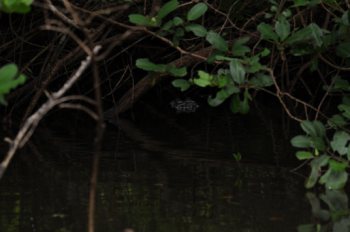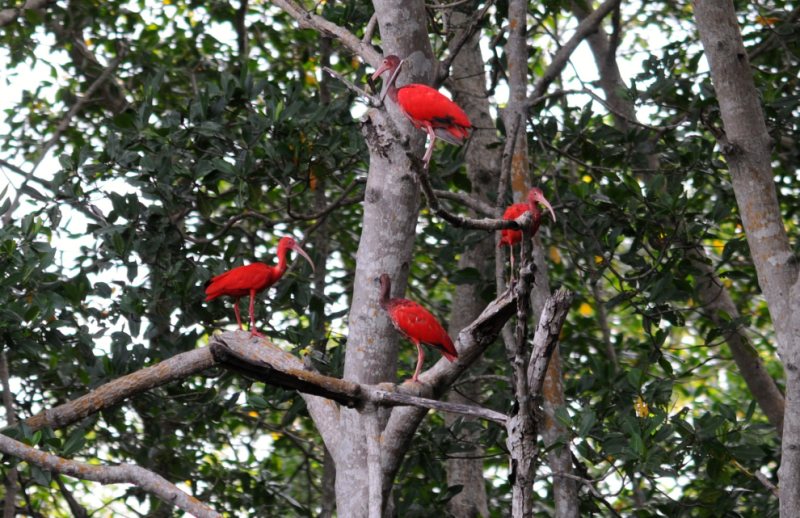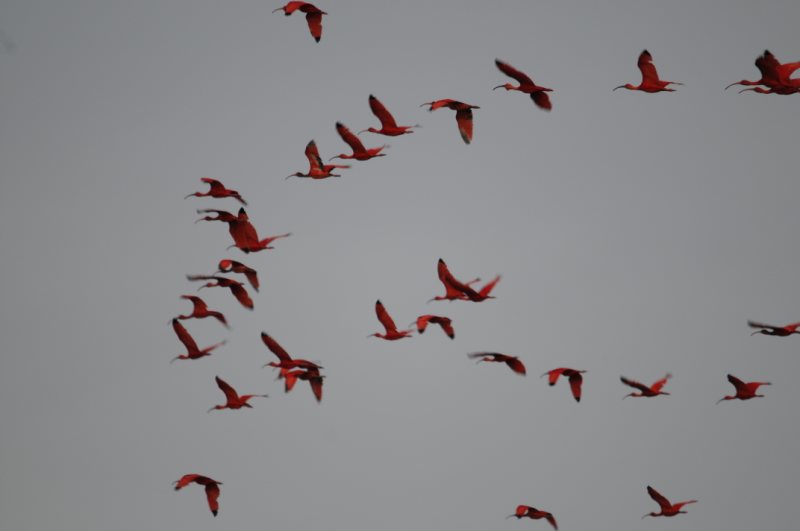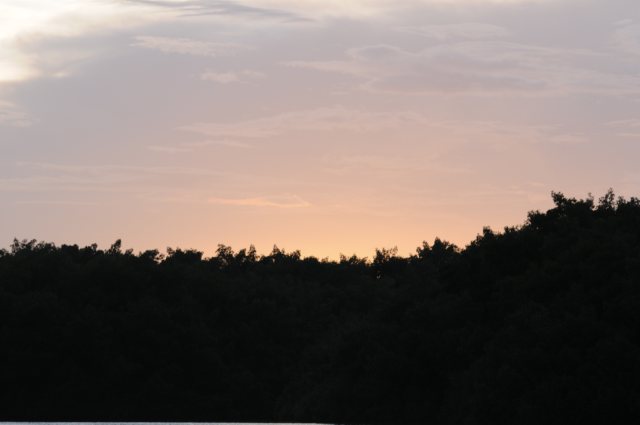|
The
Birds of Trinidad and Tobago
A total of four hundred and sixty
nine species of birds have been recorded on the islands of Trinidad and
Tobago.
There are few places
in the world where so many bird species can be seen in such a small area, many
of them unique, very rare, or of particular interest. They range from the many
species of hummingbird to the cave-dwelling
oilbird (which uses echo-location to
fly in the dark) and the spectacular and my personal favourite the Scarlet Ibis.
A big wish was to photograph this unique, brightly coloured bird before leaving
these shores in search of the Frigate bird nesting on Barbuda. The islands are within a few miles of Venezuela, and the species are therefore typical of tropical South
America. However, the number of
species is relatively impoverished compared to the mainland, as would be
expected with small islands. The resident breeding birds are augmented in the
northern winter by migrants from North America, although the range of migrant passerines is very
limited compared to Central America. Species
in the list occur on both islands except where indicated. Tobago has only about
half the number of bird species of Trinidad, but 22 birds have occurred only on
the smaller island, including 12 breeding species. Some of the smaller islands
off Tobago, such as Little Tobago, have important
seabird breeding
colonies.
The Incredible List of
Birds to look out for
Non-passerines: Tinamous. Grebes. Shearwaters
and petrels. Storm-petrels. Tropicbirds. Pelicans. Boobies and gannets.
Cormorants. Darters. Frigatebirds. Bitterns, herons and egrets.Ibises and spoonbills. Storks. Screamers. Ducks and geese. New
World vultures. Ospreys. Hawks, kites and eagles. Caracaras and falcons.
Chachalacas, guans and curassows. Limpkins. Rails, crakes, gallinules and
coots. Sungrebes. Jacanas. Oystercatchers. Avocets and stilts. Thick-knees.
Plovers and lapwings. Sandpipers and allies. Skuas. Gulls. Terns. Skimmers.
Pigeons and doves. Parrots, macaws and allies. Cuckoos and anis. Barn Owls.
Typical owls. Oilbirds. Potoos. Nightjars. Swifts. Hummingbirds. Trogons.
Kingfishers. Motmots. Jacamars. Toucans. Woodpeckers and
allies.
Passerines: Ovenbirds. Woodcreepers. Typical
antbirds. Antthrushes and antpittas. Cotingas. Manakins. Tyrant
flycatchers. Swallows and martins. Wagtails and pipits. Wrens. Mockingbirds and
thrashers. Thrushes and allies. Gnatcatchers. Vireos. New World warblers.
Bananaquits. Tanagers. Buntings, sparrows, seedeaters and allies. Saltators,
cardinals and allies. Troupials and allies. Siskins, crossbills and
allies.
And another wish is to picture my / our first toucan in
the wild.
The end of the visit
to the Asa Wright Centre is to then go to the Caroni
Swamp. The Caroni River is the largest river in T&T,
running for twenty eight miles from its origins in the Northern
Range on the island of
Trinidad, through the northern
lowlands of the Caroni Plains and enters the Gulf of Paria
(real pirate territory, the reason we cannot sail to Venezuela, unless you give
it an incredibly wide berth and in the company of others) at the Caroni Swamp. The Caroni and its
tributaries drain one of the most densely populated part of Trinidad, the
"East-West Corridor", and also provides most of
its drinking water through the Caroni-Arena Dam. Point and non-point
pollution is thus a major concern, as
is the deforestation of its watershed on the
southern slopes of the Northern Range. The banks of the Caroni River are one of
the two main sites for Hindu cremations.
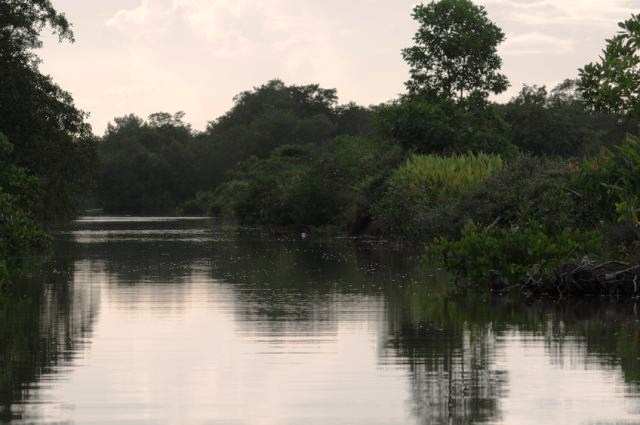
Before we got to the swamp Jessie stopped and bought us all "doubles".
Patties of corn bread with spiced, stewed chickpeas or curried chickpeas. We
tasted our very first doubles. Very tasty but a bit messy to eat as we got
aboard the boat for the trip with Shaun. Born and bred in the area - he is well
known as the local expert. His grandfather started the business, followed by
Shaun's dad, at the age of twenty one his knowledge of the wildlife and where to
find them was quite extraordinary.
The first creature Shaun
pointed out was a dozing Cook's Tree Boa. This non
venomous snake didn't take too kindly to a Canadian woman rudely awakening him
and started to waggle his tongue, needless to say the tourist then sat
quietly.
Next was a spectacled caiman.
The spectacled (white) caiman (Caiman
crocodilus) is a crocadilian reptile found in much of Central and South
America. It lives in a range of
lowland wetland and riverine habitat types and can tolerate salt water as well
as fresh; due in part to this adaptability it is the most common of all
crocodilian species. Males of the species are generally between two and two and
a half metres, while females are smaller, usually
around one and a half metres. The species' common name comes from a bony ridge
between the eyes, which gives the appearance of a pair of spectacles. We would
never have spotted him hiding - it took Shaun to show us where to
look.
The real stars of our show. Luckily
we saw these, the only ones sitting in a tree on our route. The bulk are in
protected nesting grounds and as it is breeding season we were forbidden to go
near them.
The Scarlet Ibis (Eudocimus ruber), sometimes also referred
to as "Out of Gamut Ibis", is a species of ibis that inhabits tropical South America and also
Trinidad and Tobago. It is the national bird of
Trinidad and is featured on the Trinidad and Tobago coat of arms along with Tobago's national bird, the Rufous-vented
Chachalaca. Adults are 56–61 cm long and weigh 650g. They are completely
scarlet, except for black wing-tips. They nest in trees, laying two to four
eggs. Their diet is fish, frogs,
reptiles and crustaceans.
First we saw a
couple and got really excited, then some more in the
distance.
Then many
hundreds
A juvenile Scarlet Ibis is dark grey, sometimes black and white; as it grows the
ingestion of red crabs in the tropical swamps gradually produces the
characteristic scarlet plumage. The birds leave the roosts and go off feeding
for the day, must ask Jesse if he can organise a trip for us to watch them
during the day. The life span of Scarlet Ibis is approximately fifteen years in
the wild and twenty years in captivity. This species is very closely related to
the American white ibis and is sometimes considered
conspecific with it. While the species may have occurred
as a natural vagrant in southern Florida in the
late 1800's, all recent reports of the species in North America have been of
introduced or escaped birds. Eggs from Trinidad were placed in White
Ibis nests in Hialeah
Park in 1962, and the resulting
population hybridised with the native ibis,
producing "pink ibises" that are still occasionally seen.
Then the sky was full of
thousands of birds
Then all went
quiet and off we went.
ALL IN ALL ONE OF THE
MOST COLOURFUL DISPLAYS IN NATURE
|





